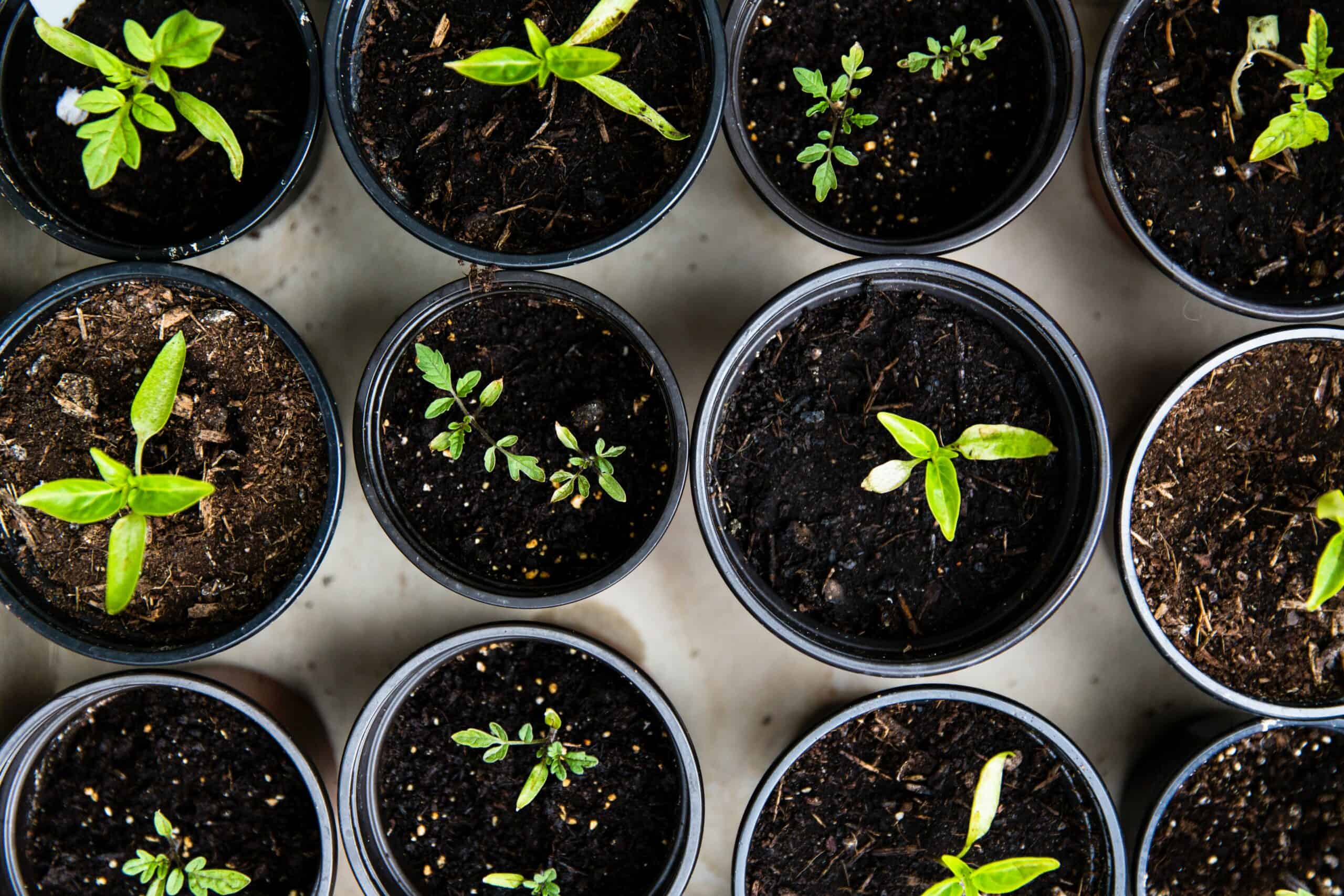It’s fun to buy seeds (they are inexpensive!) and to imagine yourself growing lots of vegetables and fruits. But don’t buy anything until you learn which types of plants grow well in your area. Here I explain how to start a vegetable garden for people new to gardening. Read this before you buy anything.
There is nothing like the taste and satisfaction of growing your own fruits and vegetables. But it can be costly and a waste of time if you don’t know what you are doing and nothing grows. Keep reading to learn what you need to know to begin.
What’s really important is to grow appropriate plants for your climate during the right season. This will help ensure your plants will produce fruits.
Beginner Gardener Tip
One great tip is to go to a home improvement store (like Lowe’s, ACE Hardware, Menards, Home Depot, etc.) and see what plants they are selling. If they are available, chances are those plants will grow in your climate in that season.
If you go to a nursery, they will have many more plants which may or may not be appropriate to grow in the current season. Ask before you buy.
When you want to start gardening, it can be overwhelming. Years ago, when I first began, it was difficult because I thought I could simply buy seeds from my local hardware store, plant them in the spring and summer, water them, and expect success.
I’d usually get some sprouts or even a few inches growing. However, rarely did they bear fruit.
Once I learned about what grows well where I live, the correct season to plant, and about enriching the soil, my vegetable gardens thrive! (And I never use fertilizer.)
No matter how much space you have or your skill level, here’s how to start a food garden. You can use this information to help you grow from seeds, plant starts, and/or fruit and nut tree saplings.
How to Start a Vegetable Garden for Beginners
Before you buy anything, read through this. It will save you from wasting time and money.
1. Learn Your Climate Zone
The USDA Plant Hardiness Zone Map divides North America into 13 different zones. Your hardiness zone, also called climate zone or planting zone, is the same all year long. Once you know it, remember it. This is the most important thing to know. It is essential for successfully growing food, especially when planting from seeds.
Different plants thrive in different climates, so you’ll need to know your local climate conditions. If you don’t know what yours is, check out the USDA hardiness chart below. It will be a number 1 – 13 with an “a” or a “b”.
Don’t worry about the degrees. Simply learn your number and whether it’s a or b. Know your hardiness zone so you can choose plants that will thrive in your region. Keep reading for what to do next.
Importance of Hardiness Zones in Gardening
- Teaches you which plants are suited to your climate and should grow well
- Tells you the time of year to plant (which season)
- Helps you avoid mistakes. Some fruits and vegetables won’t grow in certain regions, no matter how hard you try.
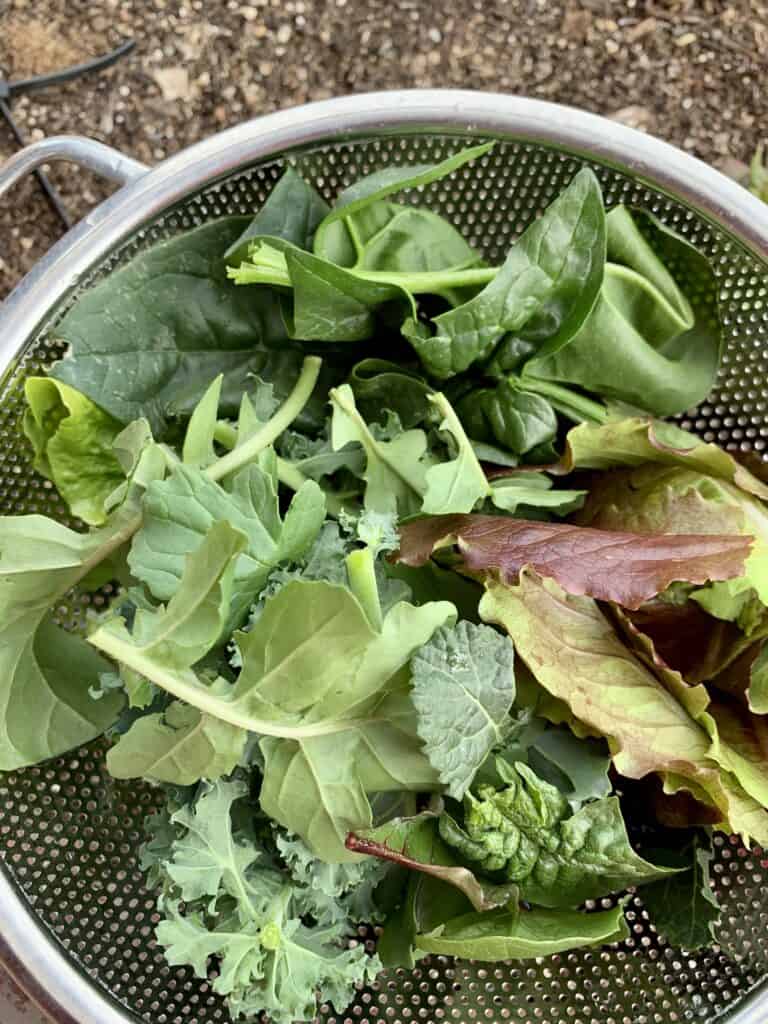
2. Choose Where to Garden
Depending on where you live, you may have options for where to plant and what to plant in, or not. Gardening options:
- Garden plot directly in the soil
- Raised garden beds
- Pots and containers
- Greenhouse gardening
- Hydroponics systems
- Aeroponics system
- Aquaponics
I listed soilless gardening methods above because they are options for growing and may make sense for your space and interests. However, I’m going to discuss soil gardening.
There are pros and cons to growing in containers, garden beds, and in the ground. Work with whatever space you have. It doesn’t have to be in the backyard. Perhaps the side or front would work, depending on which way your house faces. Learn more about planting in the ground vs raised beds vs pots and containers.
Gardening doesn’t have to take up a lot of room. It’s better to start small when you are a beginner. It’s better to it right and be able to care for your plants to actually grow vegetables and fruits than to be overwhelmed and tired of watering, etc. before anything is ready to harvest.
If you are in an apartment or condo, you can plant in containers or a small hydroponics system. If you live somewhere with a backyard and already have garden beds, fill them with high quality soil enriched with compost, and use them.
If you already have large, immobile pots, a raised garden bed, and/or a dedicated in-ground garden spot, use them to begin your garden.
Learn more:
- Mini garden on the balcony
- Grow strawberries in planters
- Planting potatoes in containers
- Grow potatoes in 5 gallon buckets
- Growing tomatoes in pots (Be sure to plant determinate tomato varieties!)
If you don’t have anything yet, consider the following:
What to Consider When Choosing a Garden Spot
When choosing potential areas to garden on your property, it’s important to consider the available resources. These include:
- What do you already have: a raised bed, large planters and pots, etc.
- Quality of soil – clay is difficult to grow in
- Availability and access to water
- Sunlight – north, south, east, west considerations; need 6+ hours of direct sunlight daily
- Shade – may be necessary in hot climates
- Access to the garden
- Ability to protect from animals if necessary
Some of these things you can change. One example is if you plan to garden directly in the soil or garden bed but it’s in an area that may attract raccoons, deer, and other pests. You can build a garden enclosure.
Another example is if you can trim a tree to make way for more sunlight.
One thing you cannot change is if there isn’t a water source nearby. If you will have to carry water a great distance, this is unsustainable.
Also consider future gardening expansions. You may want to build a raised bed near an area where you can capture rainwater from your roof in a rainwater cistern.
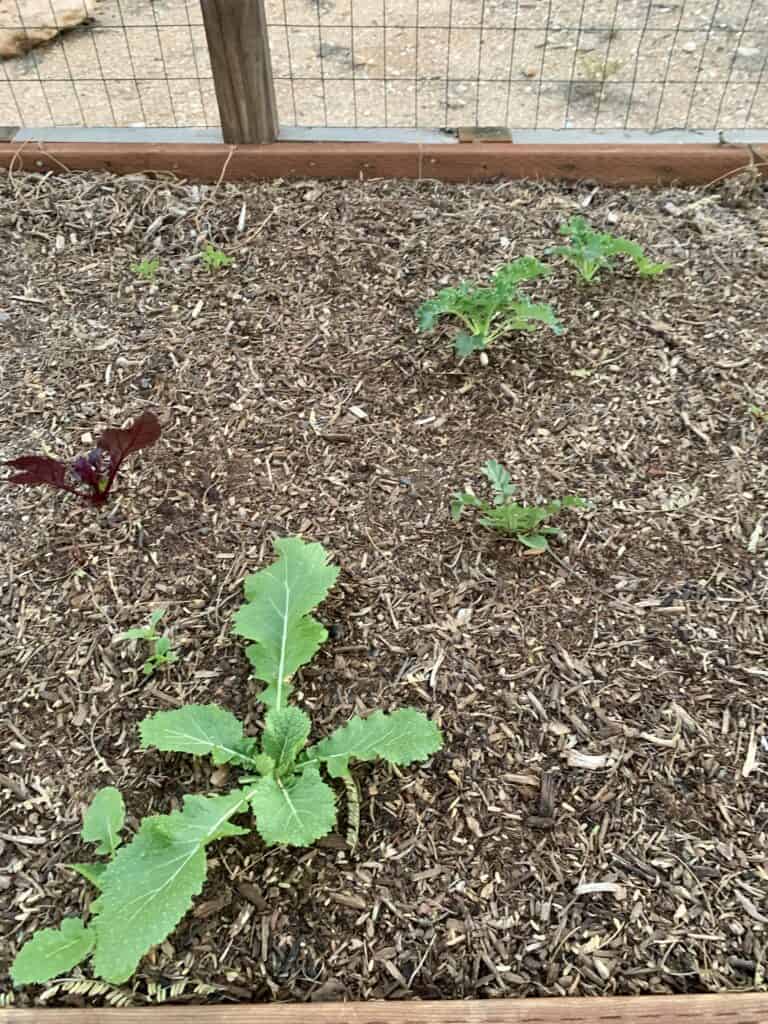
Before Deciding on a Location (If You Have Options)
Evaluate Soil Quality
The soil is where your plants get their nutrients. This means it must be rich, well-draining, and free from contaminants. You can get a soil testing kit from a local nursery to check the soil’s pH and nutrient levels but it’s not always necessary if you plan to enrich the soil.
Wherever you choose to garden, it’s best to bring in new soil and compost. You should also have a plan to enrich it (by topping it off) with every new planting.
The biggest concern is if you are planning to dig out a plot in your yard and plant a garden directly in the ground. If there is poor draining soil and/or a lot of clay, you probably should look for another area.
However, if you are planning on using only a few square feet of gardening space and not a large area, it may be doable for you. Just know it will take more soil and effort to bring it up to suitable growing conditions. It may be better to choose a different location.
Filling containers with high quality potting soil is a great way for beginner gardeners to get started without needing it to become a big project.
Consider Access to Water
Your garden will need regular watering, especially in the growing and fruiting stages. Make sure you choose a location that has easy access to a water source. Will you set up irrigation, a sprinkler, or water by hand? If you are setting up a water cistern, consider its proximity to the garden.
Assess Sunlight Needs
Food-producing plants require full sun. To grow fruits and vegetables successfully, they need at least 6 – 8 hours of sunlight a day. Observe your potential garden area throughout the day to assess sunlight exposure.
Which Side of the House to Garden for Sun Exposure
Understanding which side of the house to plant on can impact the success of your garden significantly. Each side receives varying amounts of sunlight and wind exposure. These affect temperature, moisture levels, and the plants’ health.North side:
South side:
East side:
West side:
3. Prepare the Soil
Once you have chosen where you want to garden, you MUST enrich the soil if you want anything to grow and fruit. Here’s how to get your soil ready for planting:
Optional: Test existing soil
I don’t do this because I bring in bags of new organic soil, compost, vermiculite, and peat moss with every planting. However, if you are curious, it may be helpful to know the pH and nutrient levels of your soil. If the soil is too acidic or alkaline, certain nutrients become unavailable to plants. Adjust the pH if necessary with lime or sulfur according to the test results.
Add new topsoil
In addition to enriching the soil with compost, etc., you should plan to add some high quality soil. Choose potting soil for pots. Choose organic when you can find it and if it fits your budget. I think it’s very important to choose organic soil when growing food.
Add organic matter
Compost, well-rotted manure, or other organic matter can be mixed into the soil to increase its fertility and water retention.
Another proven tactic I often use is the square foot gardening recommendation. It’s adding 1/3 compost, 1/3 vermiculite, and 1/3 peat moss to the soil. It’s an easy way to amend soil to ensure it drains well and has nutrients.
Till and turn
Tilling the soil and breaking it up is important. Turning the soil allows roots to penetrate more easily. You can do this by hand with a hand shovel in a garden bed. Use a hoe or rototiller for larger areas.
Learn more:
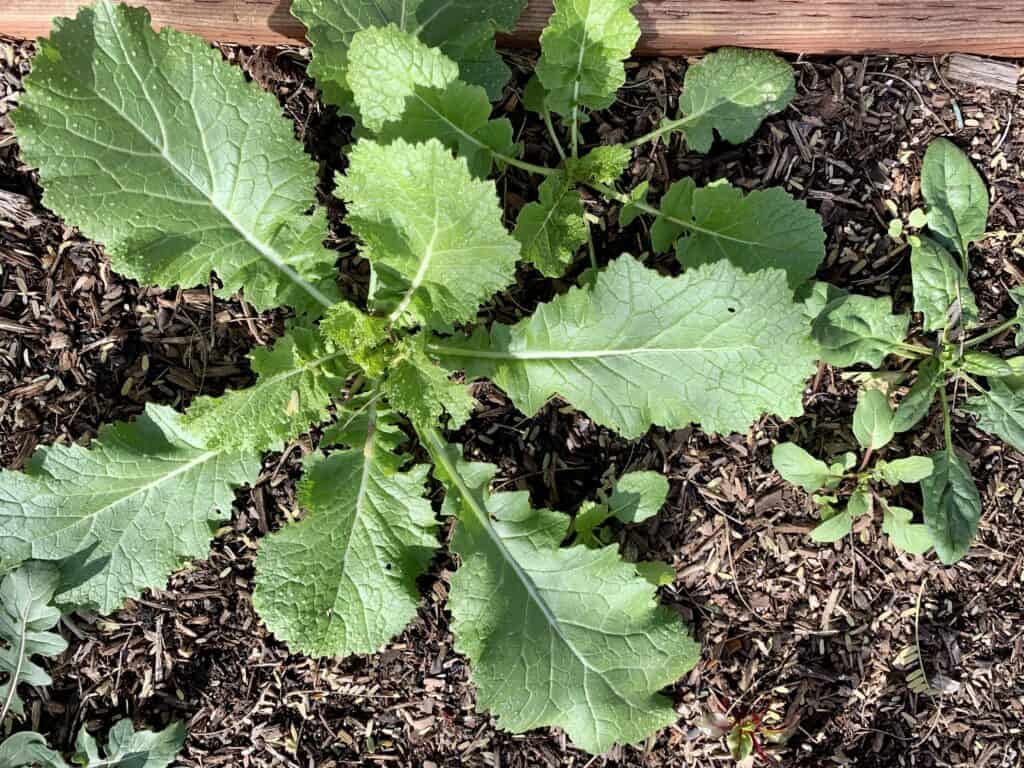
4. Choose the Right Plants for Your Climate and Plant Them in the Correct Season
You may be able to grow zucchini, squash, or beans better than figs, kumquats, or cantaloupe.
As I said earlier, a beginner tip is to visit your garden center or home improvement store. Check out the plants they offer. They’ll have plant starts, also known as transplants or seedlings, suitable for your area’s current season. These are plants you can move to a larger container or garden.
If you go to a large local nursery, they will likely have plants in greenhouses that are suitable for your region. However, they may or may not be appropriate to plant in the season it is. Ask them what you can plant now.
Some examples of what I am talking about:
Gardening in 9b Example
I live in southern Arizona, in hardiness zone 9b. We have a dry climate with mild winters and very hot summers.
In the springtime where I live, stores such as Home Depot and Lowe’s will sell citrus trees (lemon, lime, orange, kumquat, and more), pomegranate and fig trees as well as tomato plants, pepper plants, zucchini, herbs, and more. Even my local Costco sells lemon trees, lime trees, and orange trees!
If I went into these same stores in the Chicago area, 5b or 6a, I wouldn’t see citrus, fig, and pomegranate trees for sale.
Planting From Seeds
If you want to grow from seeds, check your hardiness zone to ensure:
- The seeds can grow in your region
- What season to plant them in
It’s really important to understand, just because something grows well in your region, it will likely only grow well if you plant it at the right time. Timing is everything.
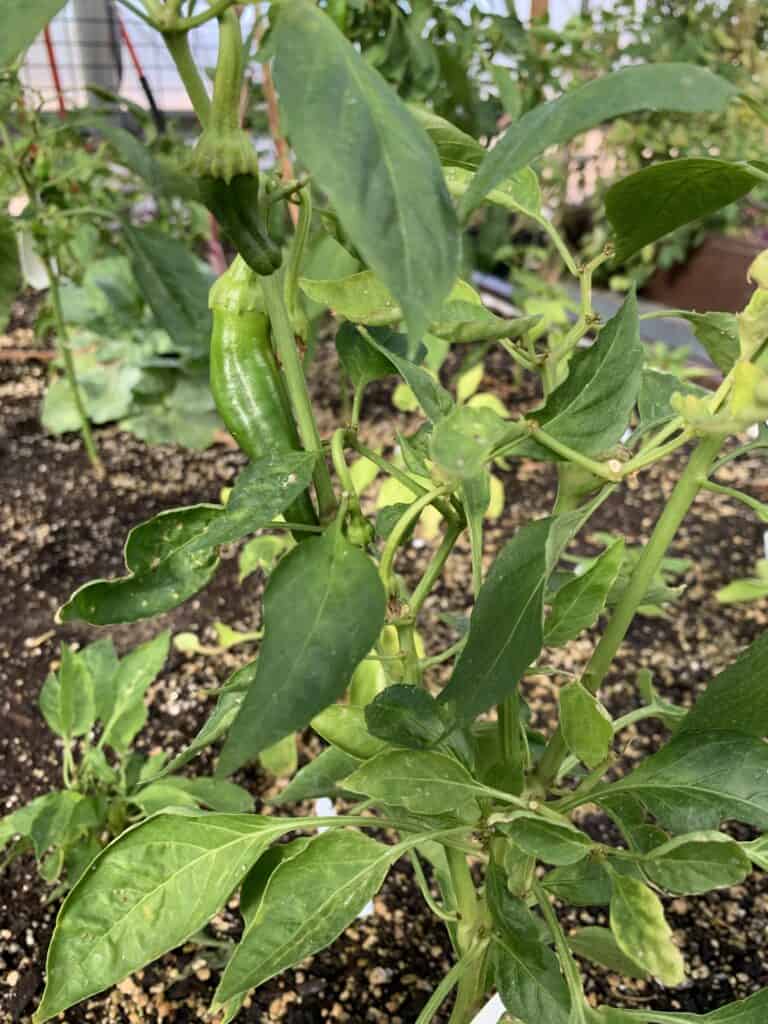
What to Plant
If you browse your local nursery, you will see lots of different plants you can grow. Plant starts are available in different sizes, depending on the type of plant it is. They may be a few inches tall or a plant that’s already growing food.
Examples are a basil plant or cilantro plant with leaves already ready to harvest. You may see established tomato plants, large and small, with green tomatoes or red tomatoes already.
Or you may find small pepper plants or strawberry plants that are growing but not producing visible fruits yet.
It’s exciting to see all of these plants. It may be a bit overwhelming as well. Be sure not to buy everything. You need a plan and need to be flexible in case you can’t find what you want or if what you want is too expensive.
Seeds are cheaper than buying transplants.
Again, if they are selling plant starts, it’s likely it will grow in your area in that season. You can probably buy any of the starts and be successful assuming you are meeting the sunlight, soil, and watering needs.
An example of this is growing leafy greens in gardening zone 9b. With the mild winters, I am successful with winter vegetables such as growing Swiss chard, spinach, lettuce, kale, arugula, radishes, beets, and carrots in the colder months until early spring.
I grow bountiful crops of all of these. However, these same plants would not grow well in our hot summers.
My friend who lives in Anchorage, Alaska (zone 4b) grows many leafy greens and root vegetables in the summer months because of their cooler climate.
Learn more:
Examples of What to Plant By Hardiness Zone
Each hardiness zone represents a 10°F difference in average annual minimum winter temperature. This helps gardeners determine which plants should grow well in their region. Below are some examples of what grows well.
Zones and Examples
Keep in mind, there are also differences between whether your zone has an “a” or a “b”. But here are some examples of what grows in general.
Zone 3: Parts of Alaska, Midwest northern regions
- What thrives: Cold-hardy vegetables like kale, cabbage, and Brussels sprouts
Zone 4: Upper Midwest, Northern New England
- Root vegetables like radishes, carrots, beets, parsnips
Zone 5: Parts of Nebraska, Iowa, Ohio, Illinois
- Leafy greens, broccoli, tomatoes, peppers, cucumbers, strawberries
Zone 6: Parts of Missouri, Illinois, Indiana
- Apples, cherries, beans, cucumbers
Zone 7: Parts of Virginia, Oklahoma, Arkansas
- Peaches, plums, nut trees, leafy greens, tomatoes, corn; plants with medium-length growing season
Zone 8: Coastal Pacific NW, South Carolina
- Citrus, figs, blackberries, melons
Zone 9: Florida, southern Texas, parts of California, parts of Arizona
- Avocados, bananas, tropical fruits, sweet potatoes, okra, leafy greens in winter
Zone 10: Southern Florida, southern California
- Papayas, guavas, passion fruit, and most tropical varieties
Zones 11 – 13: Hawaii and the U.S. territories
- Tropical and subtropical fruits and vegetables
Beginner Tips for What to Plant
- Choose organic seeds when possible; there is a negligible price difference versus “regular” seeds.
- Choose organic herbs if you see them. Again, the plants are just a few dollars more.
- Avoid buying plant starts with small stakes that say “Miracle Grow”. Add your own organic fertilizer if you choose. Use high quality soil, and most plants won’t need fertilizer.
- Plant what you or your family likes to eat.
- Consider the variety. If you love tomatoes in salads, consider if you also want to make sauce or salsa. This well determine whether you should buy and plant indeterminate tomatoes which ripen throughout the season and sprawl out like vines or determinate tomatoes (plants grow more like bushes; fruits ripen around the same time; good for sauce, etc.)
- Some plants are easy to grow (tomatoes, peppers, zucchini) while others can be more challenging (celery and cauliflower).
- Learn about companion plants.
- Consider Days to Maturity (DTM).
Companion Plants
There are some plants that grow well together. These are called companion plants or complementary crops. One may repel insects or provide shade. They likely don’t compete for the same soil nutrients. Some popular companion plantings include:
- Dill, basil, tomato
- Carrots, onions, leeks
At the same time, there are some plants you shouldn’t plant next to each other.
- Watermelon, zucchini, cucumber
- Spinach, potatoes, fennel
- Onions, beans
- Broccoli, tomatoes
Learn more:
Days to Maturity (DTM)
Look up the days to maturity (DTM) when you are planting from seed. Some crops mature faster than others. This is important if you are planting early or late in the season. Planting crops with short DTMs means you may be able to plant a second planting. Be sure to rotate crops.
Some crops and varieties of crops have short season, mid-season, or long season DTMs. If you are planting late in the season, you may want to choose a short-season variety which produces fruit quickly. This is important if you plant in the fall to avoid frost.
Learn more:
- How to harvest basil
- When to harvest beets
- When to harvest potatoes
- How to tell if a pomegranate is ripe
5. Diversify Plants as well as Seeds and Starts
Companion planting as well as diversifying your garden is important. Don’t plant all the same thing next to each other in your garden. If you have an entire bed of tomato plants and have an infestation of tomato hornworms, they can wipe out your entire crop in days if you aren’t checking on them regularly.
Also, you want to have success growing. There are many variables at play when you garden. Even when planting the right plant in the right season, sometimes things don’t grow like they should. It’s better to diversify your garden to improve your chances of success.
Choose a Variety of Seeds and Starts
Along the same lines as choosing different types of fruits and vegetables to grow, you may also want to grow some from seed and some from starts, if possible.
You can buy organic seeds online or go to local nursery, hardware store, home improvement store, or retailers such as Walmart. I choose organic seeds or heirloom varieties when possible. For the modest price difference, I think it’s worth it. Do what your budget allows and what is available.
6. Plan It Out and Write It Down
Take a piece of blank paper and list out everything you bought. Take another paper and roughly draw out all the areas you have to plant. This layout should include whatever you are growing in (raised beds, large and small pots, etc.).
Spell out what you will plant in each area. You may want to grow herbs in pots near your home for easy access and the tomatoes and sprawling cucumbers in the garden bed. Consider companion plants as well as what not to grow next to each other.
Write down everything you are planting and where you are planting it. This will help you remember what you planted, especially when planting seeds. It will help you know what you did right and what you need to improve on for next time. It will also serve as a reference to be sure you rotate crops for the next time you plant in that spot.
Learn more:
7. Plant Your Garden
Sow Seeds or Transplant
Some plants are best sown directly in the garden, like carrots and beans. Others might be started indoors or bought as young plants, like tomatoes and peppers. Follow the instructions on seed packets or plant tags for spacing and depth.
If you plant several seeds in one hole, once the seeds germinate (start growing), you can snip the smaller ones and keep the strongest.
Water
The right amount of water is crucial. Too little and your plants will be stunted; too much, and they might rot. A general rule is 1 inch of water per week, either from rain or watering. Try to avoid getting the leaves wet when watering by hand.
Water your new plants or seeds gently and thoroughly. It encourages the roots to grow deep into the soil. Once they are established, you can water them less.
In drier regions, you will need to water more than the 1″ per week that’s typically recommended. Consider rainfall as well. Do not overwater.
Learn more:
Mulch
Mulch helps retain soil moisture and suppress weeds. Straw, grass clippings, or shredded leaves all make good mulch for a vegetable garden. I used alfalfa one year when I was growing in the heat of summer, and it helped keep the soil cooler.
You don’t have to do this, but it can be helpful in certain regions.
8. Protect from Pests
Pests can be anything that disturbs or eats your garden. These include mammals, javelina, birds, insects, nematodes (microscopic worms), slugs, snails, etc.
Rotating crops and enriching the soil with each new planting will help deter (non-mammal) pests.
If you have your garden set up on irrigation, it’s easy to forget about it. Don’t! Check on your garden regularly to look for signs of chewed leaves. Look around for tomato hornworm, caterpillars, and other insects. Remove them. The earlier you catch a problem, the easier it will be to manage.
Dealing with mammals and javelinas
In my walled off backyard, I have tall pots. I’m not worried about critters like rabbits. However, the packrats like to strip leaves from my kumquat trees. I don’t have to worry about deer or javelina.
However, I needed to enclose my raised beds which are in my side yard in an open area. The first year gardening, I had a thriving garden, overflowing with fruits and vegetables. The next year, however, the javelina or deer found it. My tiny, growing-from-seed plants were all destroyed.
My father-in-law helped us enclose the garden and all is well again.
Learn more:
- How to keep animals out of garden without fences ~ 10 Methods
Dealing with birds
Birds often eat my ripening tomatoes. When they are almost ready to harvest, I go out everyday to pick them. Sometimes I pick green tomatoes and ripen them indoors. Sometimes I cover the plants with netting.
Dealing with plant-destroying insects
There are many non-chemical ways to manage pests. You can introduce beneficial insects like ladybugs, use regular dish soap, or set up physical barriers like row covers.
9. Care for Your Garden
Your seeds and starts are in the ground, but your work isn’t done yet! Be sure to:
- Water
- Thin: If growing from seed, remove competing seedlings growing in the same space.
- Weed: Weeds compete with your plants for water, nutrients, and sunlight. Remove weeds regularly.
- Fertilize (optional): Some plants, like corn and tomatoes, are heavy feeders and might need additional nutrients during the growing season. Organic options like fish emulsion or compost tea can be used.
- Watch for pests
Some plants may require pruning to encourage fruiting or prevent disease. An example is removing suckers from indeterminate tomato plants.
10. Ask Others
When I was a beginner gardener, I didn’t even know what to ask people I knew who gardened successfully. After I planted my first crop, I had questions to ask.
Do you have neighbors and local friends who garden? What do they have success growing and what aren’t they able to grow? You can also look online for gardening communities in your area. Facebook can be a great resource when you find a gardening forum for your region.
Check your local library to see if they have books for gardening in your region. They also might have gardening classes or specific topics such as growing tomatoes in pots, etc.
11. Rotate Crops the Next Season
Hopefully you have a successful beginning gardening season and want to keep at it. Be sure to not plant the same plants in the same place two plantings in a row. Planting different crops will help minimize diseases by disrupting the life cycles of soil-borne diseases.
Enrich the soil between plantings, and plant something different. This will be easy if you have a spring garden and a fall garden. It’s likely you will be planting different things anyway.
Beginner Gardening Tools
The right tools can make all the difference in gardening, especially when you’re just starting out. But buy only the basics. You may find you love or hate gardening. If you love it and want to continue, then expand from there as your budget allows and as you learn what would be helpful for your situation.
I start with the 3 most important gardening tools for beginners. If you have a large plot, you will likely need additional tools. A great way to save money is to check Goodwill.
Hand trowel aka small shovel
If you are only buying one thing, buy a small hand trowel which is a small shovel.
Watering can or hose with spray attachment
Water is essential for your garden. Even if you plan on setting up an irrigation system, a watering can or hose with a spray attachment will help you water your seeds, seedlings, and plants. Before plants are established, it’s especially important for you to water gently so you don’t disturb the seeds.
If you don’t have money for a watering can, save a plastic gallon milk jug or plastic juice container.
Garden gloves
I think gardening gloves are in the top of essentials for beginner gardeners. A decent pair will protect you from thorns and help keep your hands clean. Look for gloves that are durable and fit you well.
Garden hoe
A hoe is used to shape the soil, control weeds, clear soil, and harvest root crops. A sturdy hoe can save a lot of effort in preparing and maintaining your garden. You won’t need a hoe if you are gardening in pots and containers. However, if you are planting directly in the ground, you will want one.
Garden rake
A garden rake helps level the soil and remove debris, preparing the beds for planting. It can also be useful in spreading mulch or compost. Again, this isn’t necessary if you are beginning gardening in containers. A rake may be difficult to use in raised beds, depending on your height.
Pruning shears
Depending on what you are planting, pruning shears may be necessary for cutting back plants, deadheading, shaping, and general pruning. A good pair of shears that fit your hand comfortably will be helpful.
Garden fork
A garden fork is excellent for turning and aerating the soil, breaking up clods, and mixing in compost or other amendments. It can be more gentle on the soil structure than a rototiller.
Garden spade
A spade is useful for digging larger holes, edging garden beds, and lifting soil. Look for one with a comfortable handle and a flat, sharp blade.
Wheelbarrow or garden cart
For larger gardens, a wheelbarrow or garden cart can be very helpful for transporting soil, compost, plants, and tools. It saves time and your back.
Compost tumbler
In time, you may want to start a compost pile. For something simple, odor free, and pest-resistant, consider getting a compost tumbler. I love mine. It’s a great way to use up vegetable and fruit scraps, paper, etc.
Learn more:
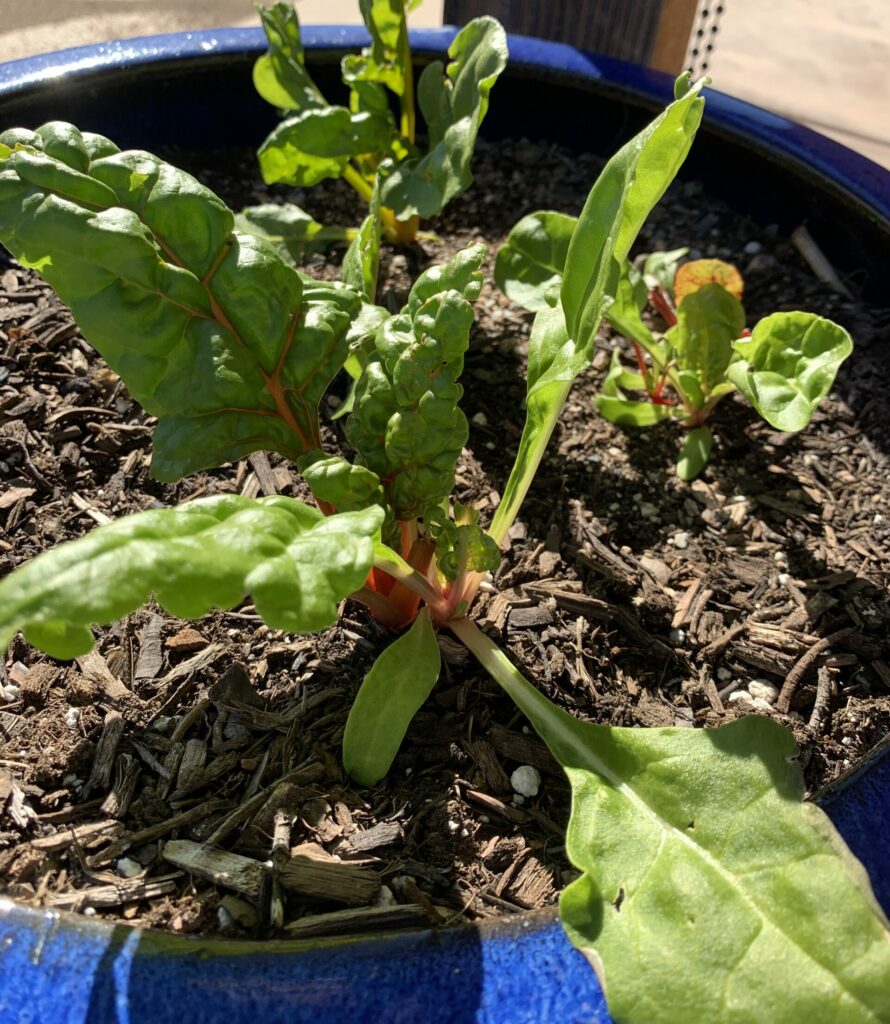
FAQs
What is the easiest way to start a vegetable garden?
The easiest way to start a vegetable garden is to choose a location that gets 6 – 8 hours of direct sunlight daily. Go to a home improvement store or nursery and choose starter plants as well as bags of high-quality soil and compost.
Prepare the growing area with the soil and compost. Then, plant your transplants, and water. Continue to care for them.
How do you start a vegetable garden step-by-step?
To start a vegetable garden, you first need to select a location that gets a lot of sun. Next, amend the existing soil by adding compost. You may also need to add bags of new soil.
Then, decide what you want to plant by learning your hardiness zone and what to plant in the season you want to garden. Go to a nursery or home improvement center and buy plants or seeds. Sow seeds or plant seedlings. Water.
What vegetables are easiest to grow for beginners?
The easiest vegetables for beginners are radishes, lettuce, green beans, and tomatoes. Be sure to plant them in the right season for your climate.
There are differences in varieties, but in general, radishes, broccoli, kale, beets, carrots, and many more are cool season crops. Warm season crops include tomatoes, melons, okra, and corn.
What month should you start a garden?
In many regions in North America, it’s typical to start a garden in early spring, around March or April. However, in hotter regions, winter gardening is common. Many gardeners have success planting in the cold months and avoiding the hot months of June – August.
In very cold regions, you should start a garden in May or June.
What vegetables should a first-time gardener grow?
A first-time gardener should focus on easy-to-grow vegetables and fruits. These include radishes, lettuce, green beans, and tomatoes. If you plant them in the correct season for where you live and provide good soil and care for them, they should grow well.
How do you start a garden for beginners?
For beginners, starting a garden involves selecting:
- An area that gets 6+ hours of direct sunlight
- A convenient location for you to keep up with watering
Before planting anything, you need to:
- Bring in new soil (may not be necessary)
- Enrich the existing soil with organic matter
When choosing what to plant for beginner vegetable gardeners:
- Choose plants and seeds that grow well in your climate in the season you want to grow in
- Choose starter plants (already-growing plants versus growing from seed yourself) which will be faster
- Select easy-to-grow plants with short days to maturity (DTM)
What month should I start preparing my vegetable garden?
This depends on where you live. If you live in a cold climate, it will be later than the typical March and April. If you live in a hot climate, it may be as early as January or February so you can grow before the summer heat.
You can get started by bringing in new soil and enriching it with compost. You may want to add equal parts compost, vermiculite, and peat moss to promote good drainage.
How do you layout a vegetable garden?
To layout a vegetable garden, plan beds or rows. I’m a fan of square foot gardening. To do this, you divide your garden into 12×12 inch sections. I mark them by stapling twine to the sides of my garden bed. This method sections off one square foot for each plant.
You must ensure there is enough space for each plant type. Also, consider factors such as sunlight, growth height, and companion planting. It’s best to vary your plantings. If you grow all the same type of fruits or vegetables, insects and diseases can invade and spread. They can wipe out your entire crop.
What vegetables should a first-time gardener grow?
First-time gardeners should opt for easy-to-grow vegetables like radishes, lettuce, bell peppers, and zucchini. Choose varieties that have a short days to maturity (DTM) date.
For example, some radish varieties are ready to harvest within 25 – 30 days from planting from seed. Some leaf lettuces and arugula can mature in 30 – 45 days. Others, such as Brussels sprouts, potatoes, pumpkin, and winter squash, can take 90 days to be ready to harvest.
For lots more new gardener questions, be sure to check out these Beginner gardener FAQs
Conclusion
Being successful when learning how to grow a vegetable garden is all about taking your time. Start small. Choose a spot on your property to set up raised beds or prepare an area to sow directly in the ground. If you are limited on space or want to keep it simple, start by gardening in pots and containers.
Learn your climate zone and what plants will thrive in your area. It’s also important to know what month to plant them so you have success.
Some fruits and vegetables mature faster than others. Learn the DTM (days to maturity). It may be fun to start with easy-to-grow vegetables so you can harvest them sooner rather than later.
Keep in mind, it’s quite easy to buy established plants versus growing from seed. Buy a few established plants, and plant them. Herbs, like basil, grow quickly. You will be able to snip leaves soon after you bring it home.
Before you plant anything, you must make the soil better. This may mean buying bags of organic soil for your raised beds or in-the-ground garden or new potting soil for your containers. You should also enrich it with compost so it has nutrients. This will help grow robust plants.
Buy organic soil and organic seeds as your budget allows. One of the reasons many people want to grow their own food is so it doesn’t contain pesticides and fertilizer.
Remember, you don’t have to go out and buy fancy tools or equipment, especially if you are gardening in a small space. A hand shovel or trowel, gardening gloves, and a watering can or plastic jug to water your plants is all you need.
Talk to neighbors and friends you live in your area about gardening. It’s a great way to connect with your community as well as learn what thrives in their gardens. You can check with other local gardening resources as well, including online communities and your local library and ag extension center.
I hope beginner gardeners will stick with it. It’s a rewarding hobby, a way to start being self-sufficient, and a chance to get outdoors and back to basics. Hopefully, you’ll also grow some food in the process. Homegrown tastes way better than what you will find in grocery stores.
Whether you have a sprawling garden or a few pots on your balcony, you can enjoy the pleasures of growing your own vegetables, herbs, and fruits.
Remember, you can be a successful gardener no matter your skill level or space constraints. Follow the tips above which is everything you need to know. Buying seeds and starts of what will grow in your area is essential. Then plant them the right time of year.
Learn more:
- 16 gardening tips for beginners
- 5 gardening mistakes
- Winter vegetables list
- Fall and winter vegetable gardens
Featured image credit: Markus Spiske, Unsplash

